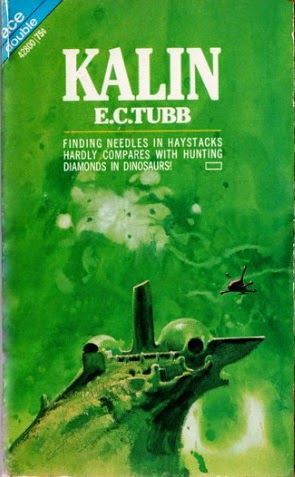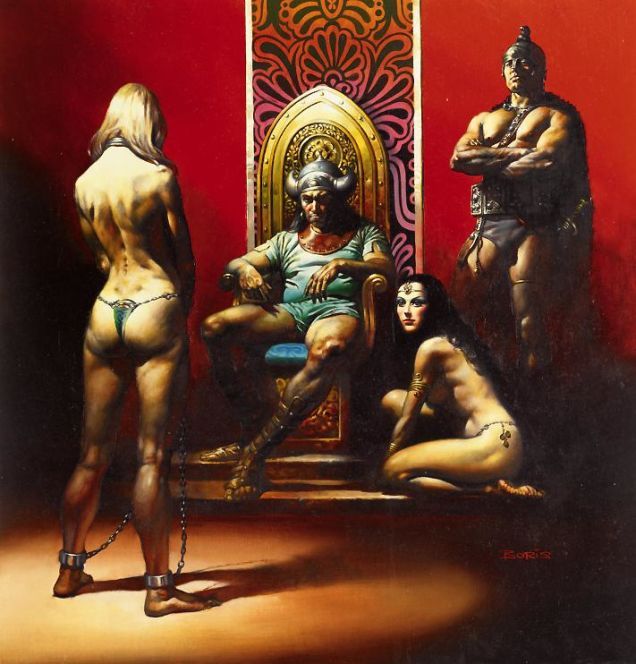 In 1969, the pulp ethos was still alive and well. In this fourth volume of the Dumarest series which came out in that year, our hero finds himself on Logis. This civilized world has an institution called the “Bloodtime”, a three day period in which all laws are suspended. Pandemonium naturally ensues as people pay off old debts and settle old scores. Buildings are set on fire. Mobs roam the streets. People armed with melee weapons track each other through the alleyways, waiting for the perfect moment to strike.
In 1969, the pulp ethos was still alive and well. In this fourth volume of the Dumarest series which came out in that year, our hero finds himself on Logis. This civilized world has an institution called the “Bloodtime”, a three day period in which all laws are suspended. Pandemonium naturally ensues as people pay off old debts and settle old scores. Buildings are set on fire. Mobs roam the streets. People armed with melee weapons track each other through the alleyways, waiting for the perfect moment to strike.
What is the essential hook that signals that there really is a book length adventure to be had…? The exact thing you see illustrated on so many pulp covers, of course: a beautiful woman in danger!
She came running down the road, long legs flashing beneath the hem of a golden tunic. It was cut away from her arms, her throat, falling to mid-thigh and cinctured with a crimson belt. Flame red hair was bound with a fillet of gold. Sandals of gold hugged her feet showing the scarlet of painted nails. Her face was deathly pale, the eyes enormous, the red lips parted as she fought for breath.
People ask what men read, and this is really it. At least, it used to be. Now if you go to the movies, it’s all “stop taking my hand!” Mad Max, for example, is reduced to the part of tagalong in his own franchise. This is not entirely new, either. Even a guy like Vin Diesel is denied a love interest in Chronicles of Riddick, her being converted into more an uber-competent variant of the best buddy archetype as early as 2004.
It’s not so much that the guy can’t get the girl in the end anymore. (That pretty well bit the bullet when John Wayne fell out of fashion.) We’re way past that now, really. No, as soon as a female character enters a scene, it is absolutely paramount that her superiority be established. It’s the only thing that matters. That’s why the bit on Stranger Things where the guy’s trying to shoot pop cans with a handgun is so dreadfully predictable. He can’t hit the broad side of a barn in spite of the fact that his meany-pants dad forced him to go hunting as a boy. As soon as the teenaged girl walks on the set, you know what the punch line will be.
The title character of Kalin is not just another pretty face, of course. She’s gifted with psionic abilities, but she is far from being a Dark Phoenix or River Tam. In fact, she never once scoffs at or sneers at the leading man. (“Aren’t you a little short for a Storm Trooper?”) The combination of stunning good looks, uncanny abilities, and a dash of naiveté means that she needs a great deal of assistance, actually. And not just from a tough guy that’s good in a scuffle, either. In a universe this rough, she needs someone with a great deal of judgement and streetwise.
This whole setup is pretty well virgin territory for me. I don’t remember seeing anything like this on television in a good while. The brunette on Bones doesn’t just have mad science skills, but she also knows kung fu. The blonde on Chuck is not just highly trained in anything to do with espionage, she also knows kung fu. The brunette on Agents of Shield is not just a whiz at computer hacking, but she gets trained in the art of kung fu starting in the second season. And the blonde on Fringe? She does all the running, shooting, car chase stuff because that’s her character’s role. I wouldn’t be surprised if she broke out a good kung fu move in a pinch, either.
I could go on. Needless to say this sort of thing has been so ubiquitous for so long now it’s hard to imagine it being done any other way. Pick up Kalin, though, and it just goes on chapter after chapter without the feminine foil ever outwitting him (“What’s this, a ranger caught off his guard?”), upstaging him, or indignantly rebuffing him. How can this even work?!

This scene does not appear in E. C. Tubb’s Kalin.
Honestly, most people I know wouldn’t even want to know. I’d ask them what they think if it didn’t take so long to even explain what I’m asking, but I suspect that if I did… then they’d probably expect this to play out like the infamous Gor stories. You know the ones. The reality is that it’s nothing like that, of course. I mean, it would be if the target audience were women. But this is for guys, so the majority of the book’s action turns out to instead be about Dumarest providing for Kalin!
I guess you could call this “provisionary fantasy” then. Granted, there are explosions and impossible odds, brawls and dangerous alien beasts; the mentat-like Cyclan are back and are up to something. For a lengthy sequence that’s supposed to pass as a far future equivalent to Humphrey Bogart and Ingrid Bergman tearing up Paris for a few days, it’s jam-packed with action. And it works, too. It works because the setting pretty well demands it:
“Is it such a bad world, Earl?”
It was bad enough. A dead-end world at the end of the line. A rolling cinder without a local population, local industry, or native assets. Without opportunity for a man to get a job, build up a stake, get the price of a passage so as to make his escape.
A federation of companies mined the planet. Their gigantic machines gouging deep into the mountains– rivers of power streaming from their atomic plants so as to fuse the buried ore by eddy currents, run it through taps and channels into molds. Second stage was refining the crude pigs, pouring into standard shapes, stacking in warehouses– there to wait for the freighters to come and ship it to the manufacturing worlds. Over the secondary smelters hung a billowing cloud of heat-borne ash. What use a cleaner when there was no one to consider?
Only the technicians, supervisors and overseers were highly paid contract men willing to stand dirt and fumes and rugged conditions for the sake of big rewards. The workers didn’t count. Slave-labor. Men who had been sold to pay their debts, who had sold themselves for their family’s sake, who had been kidnapped and stolen and who could do nothing about it.
The rest of the population consisted of stranded travelers, entrepreneurs, entertainers. The inevitable appendages to any community where there is a chance of money to be made or needs to satisfy.
Dumarest haled as they left the field. A rabble stood watching: men shabbily dressed, gaunt, eyes smouldering with desperation or dull with hopeless resignation. The collared slaves were better dressed and in better condition than the stranded. Well to one side, the plastic bubbles which housed the executive quarters shown with lambent light and warmth. Closer, nearer to the landing field, a collection of bubbles, houses made of local stone, sheds with dirt walls and weighed roofs comprised the local village. To the other side, sheltered and almost hidden in a valley was the rubbish dump that was Lowtown.
Now, if you’ve read the first three this “scrounging up the credits to buy passage off a backwater world” premise would seem to be a rehash of Winds of Gath. The whole love affair thing with a hot psionic babe that’s on the run sounds like a repeat of Derai. I don’t think it is, though. The structure of this tale is different from the others, for one thing. For another… Dumarest actually remembers Derai in this installment– which is not something that ever happens with, say, James Bonds’s innumerable sweethearts.
Traveller fans will like this one for its detailed description of a hi-jacking attempt in space. If you don’t feel like you ever got your full mileage from your animal encounter tables, there’s a good couple of chapters covering a creature situation. And if you have trouble imagining what Firefly could have been like if the crew didn’t have a freighter, then this is a book you need to read. For me, though, I can’t get enough of it because it’s such a great picture of what science fiction could be like if it wasn’t butchered to fit with the media norms of today.
I don’t remember seeing anything like this on television in a good while. The brunette on Bones doesn’t just have mad science skills, but she also knows kung fu. The blonde on Chuck is not just highly trained in anything to do with espionage, she also knows kung fu. The brunette on Agents of Shield is not just a whiz at computer hacking, but she gets trained in the art of kung fu starting in the second season. And the blonde on Fringe? She does all the running, shooting, car chase stuff because that’s her character’s role. I wouldn’t be surprised if she broke out a good kung fu move in a pinch, either.
As Sophia McDougall’s mother wryly noted in this New Statesman article, “All the princesses know kung fu now.” It’s an attempt to make up for passive female characters in the past, as well as some kind of social education about feminism.
Great book. Most of the Dumarest books are at the very least highly entertaining and at their best really good sci fi noir tales sometimes with interesting motifs and themes.